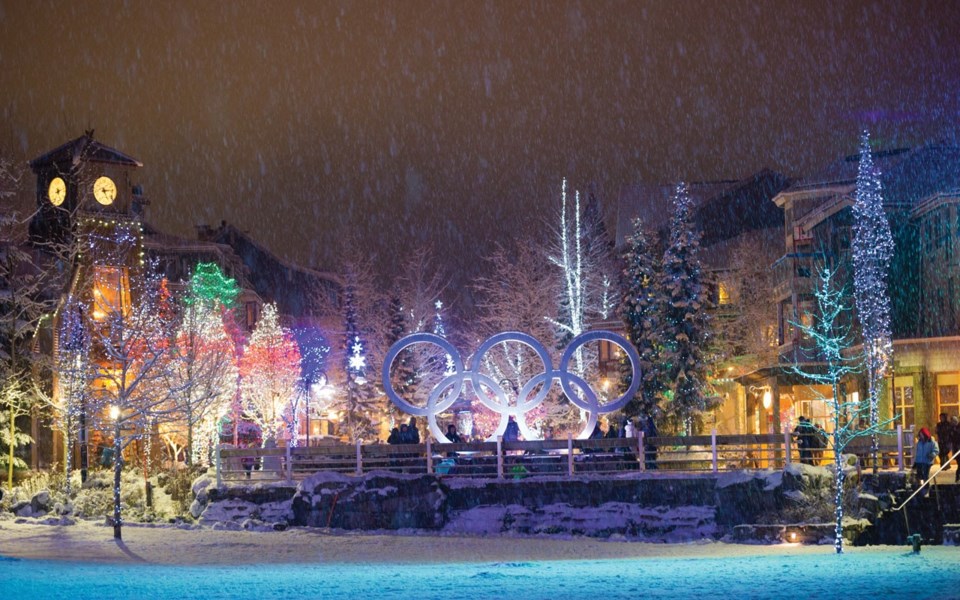During a recent chat with Mountain FM's morning show, Whistler Mayor Jack Crompton got into comparing the festive-lights programs of Whistler and Squamish.
"Even the morning show at Mountain FM agrees that Whistler's is far, far superior," Crompton joked.
"And I am convinced it's because we're more committed."
Does the new mayor take pride in Whistler's festive lighting?
"Did Led Zeppelin take pride in having the better light show?" he said.
"Of course."
Wait... did the mayor just compare Whistler's festive lighting to a Led Zeppelin concert?
"I cannot answer that question, but the festive-lights program is one of the highlights of the Whistler winter experience, and it adds to the ambience in the village over the winter season," Crompton said.
As in previous years, Whistler's holiday light show boasts between 4,000 and 5,000 strings of lights, each one seven metres long and holding 70 LED bulbs.
In total, the village contains between 280,000 and 350,000 bulbs—the trees in front of Araxi alone hold 7,000 bulbs each.
Each string uses about 4.8 watts per hour, with 5,000 strings costing about $2.40 an hour.
"The Resort Municipality of Whistler's (RMOW) village hosts often receive comments from visitors about how beautiful the lights are. My mother in law comments on them," Crompton said.
"They really bring winter to life, whether there's snow or not."
THE ART OF SNOWCLEARING
Up until a few weeks ago, Whistler's snow-clearing strategy didn't get much of a workout to start the season—bad news for powder hounds, marginally good news for municipal penny pinchers.
"The RMOW fully staffs snow clearing during late fall and winter months, so in general there's not a lot of overtime that is paid out," Crompton said. "From November 1 to December 10 this year the RMOW paid $3,199.50 less in overtime than it did in the same period last year."
The annual budget for snow clearing in 2018 was about $1.16 million.
Once the snow starts to fall, municipal crews have a set strategy to work from bright—or in this case, dark—and early.
"Primary routes including transit and school bus routes, subdivisions, main access to the highway and Whistler Village and the day lots are cleared first, starting at 4:30 in the morning," Crompton explained.
"Secondary routes are cleared starting from 10 a.m. until 1 p.m., and then maintenance of private roads such as those through strata complexes is the responsibility of private strata councils."
Depending on the conditions, some areas can turn problematic more quickly than others, but crews are well versed in the municipal road systems.
"During the winter, crews are available round the clock whenever necessary," Crompton said.
"Obviously there are locations around Whistler that are more challenging than others. Many of our staff have been around for a long time, so they understand the challenge well and are aware of how to respond."
WALK SAFE THIS WINTER
One of Crompton's first official duties as mayor since the Oct. 20 election has been presenting to all the new recruits at the Whistler Experience Program sessions.
"One of my personal key messages has been around staying off the highways as a pedestrian," he said.
"It's near and dear to my heart having run a taxi company in the past, and (having) experienced the reality of people dying on the highway."
With very few streetlights, darkly dressed, mostly invisible pedestrians on the side of the highway are an annual issue in Whistler.
Residents and visitors are reminded to always carry a light or a reflector (which can be picked up at municipal hall for free), and avoid walking on the highway when possible.
"One of the key messages to our public is that oftentimes when you're on the highway, you're only 20 or 30 feet (six to nine metres) away from a Valley Trail that can get you home safely," Crompton said.
"So use the Valley Trail whenever possible. Stay off the highway."
STEP CODE IN EFFECT JAN. 1
As of Jan. 1, 2019, Whistler officially moved to Step 3 of B.C.'s new Energy Step Code (ESC), which lays out an incremental and consistent set of regulations that will lead to more energy efficient buildings.
The ESC now applies to all part 9 residential buildings (including single-family, duplex and smaller, multi-family buildings).
"Specifically, Step 3 of the ESC will apply to all new part 9 residential buildings, Step 4 of the ESC will apply to all new part 9 residential buildings on properties applying for rezoning to increase density or permit additional uses," Crompton said.
"The implementation of the step code will increase the performance of buildings and decrease our community's overall use of energy. One of the aspects I appreciate is the clarity that it provides for contractors."
Whistler council passed its ESC bylaw—built after months of engagement with stakeholders—on July 10.
Find more info at www.whistler.ca/stepcode.




